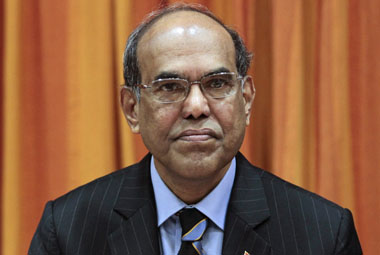It is true that the Reserve Bank of India (RBI) has to address the GDP growth fall but it will have to be allowed to do so in a manner that is not disruptive.
The sharp fall in fourth quarter GDP growth to 5.3 percent against market expectations of 6.1 percent places an additional burden on the RBI Governor D Subbarao. The central bank is fighting inflation, the rupee’s fall, liquidity and government borrowing. The below-trend GDP growth has all and sundry clamouring for the RBI to ease monetary policy. The fact is that the RBI cannot just focus on easing policy to raise GDP growth expectations. Every action of the RBI will have an effect on one macro factor or the other and the RBI has to do a fine balancing act. Hence it is advisable to stay off RBI and let its do its job.
[caption id=“attachment_327839” align=“alignleft” width=“380” caption=“The government can use the RBI as an excuse to borrow and spend more and a weakening fiscal deficit will only help weaken the rupee. Reuters”]  Governor Duvvuri Subbarao attends the monetary policy review meeting in Mumbai") [/caption]
The factors RBI has to worry about are:
a) Inflation, which is trending at 7.23 percent as of April 2012 and is above RBI’s comfort zone of 6.5 percent and below;
b) Rupee falling to a record low against the US dollar. The rupee fell to an all-time low of Rs 56.40 against the USD on the back of worries over the eurozone debt crisis and domestic growth;
c) Liquidity that continues to be in deficit mode with banks borrowing around Rs 1,00,000 crore from the RBI on a daily average basis despite RBI bond buying of around Rs 50,000 crore in April 2012 to date; and
d) Government borrowing with weekly bond auctions of Rs 15,000 crore in an environment of tight liquidity and a weakening rupee.
The RBI now has one more worry and that is raising India’s GDP growth rate. GDP growth for the fourth quarter of 2011-12 at 5.3 percent lowers the full year 2011-12 GDP growth to 6.5 percent against government estimates of 6.9 percent growth. The 5.3 percent GDP growth rate is the lowest in nine years. The forecast GDP growth rate of 7.6 percent for 2012-13 is under a cloud given the low GDP growth rate.
The government’s hands are completely tied and it cannot do anything about the fall in growth. The government is fighting to keep its borrowing down (it is borrowing a record amount of Rs 4,79,000 crores in fiscal 2012-13). It is unable to bring down its subsidy bill and is facing a huge backlash on freeing petrol prices. Topping it all is the fall in the Indian rupee (INR) against the US dollar (USD).
A fiscal stimulus is out of the question as bond markets cannot digest additional borrowing. Ten-year benchmark bond yields trended to calendar year 2012 highs of 8.70 percent at the beginning of the fiscal year on the back of worries of supply absorption before falling back to 8.50 percent levels on the back of RBI bond purchases.
What can the RBI do in the face of falling growth expectations? The central bank can ease the benchmark policy rate, the repo rate, which is at 8 percent now. However, easing of the repo rate can place further pressure on the rupee as lower policy rates reduce interest rate differentials with the US dollar, leading to rupee interest rates becoming less attractive for USD flows.
The RBI can add liquidity into the system by cutting CRR (Cash Reserve Ratio) from current levels of 4.75 percent. CRR cut of 100 bps (1 percent) will only add Rs 60,000 crore into the system, which is not enough to stabilise system liquidity that is in deficit of Rs 100,000 crore.
The RBI is buying government bonds to ease liquidity and can buy more bonds. But unchecked bond purchases by the central bank has consequences for inflation as well as the fiscal deficit. The government can use the RBI as an excuse to borrow and spend more and a weakening fiscal deficit will only help weaken the rupee.
Arjun Parthasarathy is the Editor of www.investorsareidiots.com, a web site for investors.


)
)
)
)
)
)
)
)
)



